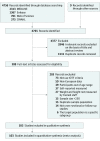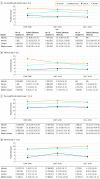Prevalence and Trends of Overweight and Obesity in European Children From 1999 to 2016: A Systematic Review and Meta-analysis
- PMID: 31381031
- PMCID: PMC6686782
- DOI: 10.1001/jamapediatrics.2019.2430
Prevalence and Trends of Overweight and Obesity in European Children From 1999 to 2016: A Systematic Review and Meta-analysis
Abstract
Importance: Studies of trends in excess weight among European children throughout the last few decades have rendered mixed results. Additionally, some studies were outdated, were based on self-reported weight and height, or included only a few European countries.
Objective: To assess prevalence trends in measured overweight and obesity among children across Europe from 1999 to 2016 using a systematic methodology.
Data sources: MEDLINE, Embase, CINAHL, and Web of Science were searched from their inception until May 2018. Moreover, searches were conducted on health institutions' websites to identify studies not published in scientific journals.
Study selection: The inclusion criteria were: (1) studies reporting the population-based prevalence of excess weight (overweight plus obesity) or obesity according to body mass index cutoffs proposed by the International Obesity Task Force; (2) cross-sectional or follow-up studies; and (3) studies including populations aged 2 to 13 years.
Data extraction and synthesis: Literature review and data extraction followed established guidelines. The Mantel-Haenszel method was used to compute the pooled prevalence estimates and their 95% CI whenever there was no evidence of heterogeneity (I2 < 50%); otherwise, the DerSimonian and Laird random-effects method was used. Subgroup analyses by study year, country, or European region (Atlantic, Iberian, Central, and Mediterranean) were conducted. Prevalence estimates were calculated as an aggregate mean, weighted by the sample size and the number of individuals in each study.
Results: A total of 103 studies (477 620 children aged 2 to 13 years) with data from 28 countries were included. The combined prevalence of overweight and obesity in the Iberian region tended to decrease from 30.3% (95% CI, 28.3%-32.3%) to 25.6% (95% CI, 19.7%-31.4%) but tended to increase in the Mediterranean region from 22.9% (95% CI, 17.9%-27.9%) to 25.0% (95% CI, 14.5%-35.5%). No substantial changes were observed in Atlantic Europe or Central Europe, where the overweight and obesity prevalence changed from 18.3% (95% CI, 14.0%-23.9%) to 19.3% (95% CI, 17.7%-20.9%) and from 15.8% (95% CI, 13.4%-18.5%) to 15.3% (95% CI, 11.6%-20.3%), respectively.
Conclusions and relevance: The prevalence of childhood overweight and obesity is very high, but trends have stabilized in most European countries. There are substantial between-country differences in the current levels and trends of overweight and obesity. The rising prevalence in some Mediterranean countries is worrisome.
Trial registration: PROSPERO identifier: CRD42017056924.
Conflict of interest statement
Figures




Comment in
-
Immer noch viel zu viele dicke Kinder in Europa.MMW Fortschr Med. 2019 Dec;161(21-22):31. doi: 10.1007/s15006-019-1225-x. MMW Fortschr Med. 2019. PMID: 31828642 German. No abstract available.
-
Three Problems in Meta-analysis of Prevalence of Obesity in European Children.JAMA Pediatr. 2020 Apr 1;174(4):389. doi: 10.1001/jamapediatrics.2019.5872. JAMA Pediatr. 2020. PMID: 32040136 No abstract available.
-
Three Problems in Meta-analysis of Prevalence of Obesity in European Children-Reply.JAMA Pediatr. 2020 Apr 1;174(4):389-390. doi: 10.1001/jamapediatrics.2019.5891. JAMA Pediatr. 2020. PMID: 32040142 No abstract available.
References
-
- Abarca-Gómez L, Abdeen ZA, Hamid ZA, et al. ; NCD Risk Factor Collaboration (NCD-RisC) . Worldwide trends in body-mass index, underweight, overweight, and obesity from 1975 to 2016: a pooled analysis of 2416 population-based measurement studies in 128·9 million children, adolescents, and adults. Lancet. 2017;390(10113):2627-2642. doi:10.1016/S0140-6736(17)32129-3 - DOI - PMC - PubMed

